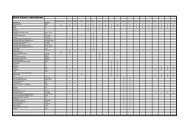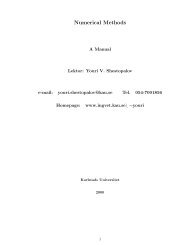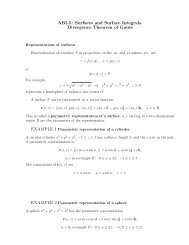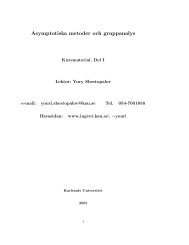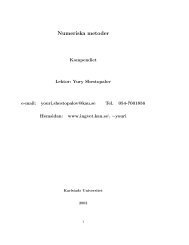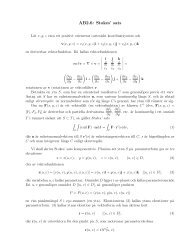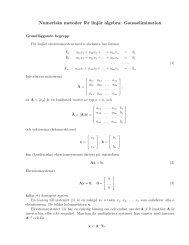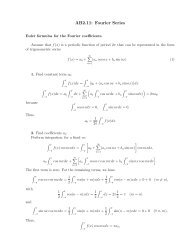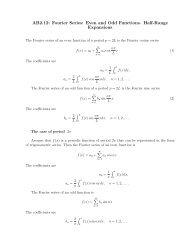emainder of the spectrum: those λ for which A − λI has a (bounded) inverse whose domain isnot dense in E, this part is called the residual spectrum.If the point λ is regular, i.e., if the inverse of the operator A − λI exists, then for sufficientlysmall δ the operator A − (λ + δ)I also has the inverse, i.e., the point δ + λ is regular also. Thusthe regular points form an open set. Consequently, the spectrum, which is a complement, is aclosed set.Theorem 11 The inverse of the operator A − λI exists for arbitrary λ for which |λ| > ||A||.Proof. SinceA − λI = −λ(I − 1 )λ A ,the resolventR λ = (A − λI) −1 = − 1 λ(I − A ) −1= − 1 λ λThis operator series converges for ||A/λ|| < 1, i.e., the operator A − λI has the inverse.Corollary. The spectrum of the operator A is contained in a circle of radius ||A| with centerat zero.Theorem 12 Every completely continuous operator A in the Banach space E has for arbitraryρ > 0 only a finite number of linearly independent characteristic vectors which correspond tothe characteristic values whose absolute values are greater than ρ.∞∑k=0A kλ k .Proof. Assume, ad abs, that there exist an infinite number of linearly independent characteristicvectors x n , n = 1, 2, . . ., satisfying the conditionsAx n = λ n x n , |λ n | > ρ > 0 (n = 1, 2, . . .). (118)Consider in E the subspace E 1 generated by the vectors x n (n = 1, 2, . . .). In this subspacethe operator A has a bounded inverse. In fact, according to the definition, E 1 is the totality ofelements in E which are of the form vectorsand these vectors are everywhere dense in E 1 . For these vectorsx = α 1 x 1 + . . . + α k x k , (119)Ax = α 1 λ 1 x 1 + . . . + α k λ k x k , (120)and, consequently,andA −1 x = (α 1 /λ 1 )x 1 + . . . + (α k /λ k )x k (121)||A −1 x|| < 1 ρ ||x||.Therefore, the operator A −1 defined for vectors of the form (119) by means of (120) can be extendedby continuity (and, consequently, with preservation of norm) to all of E 1 . The operator22
A, being completely continuous in the Banach space E, is completely continuous in E 1 . Accordingto the corollary to Theorem (9), a completely continuous operator cannot have a boundedinverse in infinite-dimensional space. The contradiction thus obtained proves the theorem.Corollary. Every nonzero characteristic value of a completely continuous operator A in theBanach space E has only finite multiplicity and these characteristic values form a bounded setwhich cannot have a single limit point distinct from the origin of coordinates.We have thus obtained a characterization of the point spectrum of a completely continuousoperator A in the Banach space E.One can also show that a completely continuous operator A in the Banach space E cannothave a continuous spectrum.8 Linear operator equations: the Fredholm theory8.1 The Fredholm theory in Banach spaceTheorem 13 Let A be a completely continuous operator which maps a Banach space E intoitself. If the equation y = x − Ax is solvable for arbitrary y, then the equation x − Ax = 0 hasno solutions distinct from zero solution.Proof. Assume the contrary: there exists an element x 1 ≠ 0 such that x 1 − Ax 1 = T x 1 = 0Those elements x for which T x = 0 form a linear subspace E 1 of the banach space E. Denoteby E n the subspace of E consisting of elements x for which the powers T n x = 0.It is clear that subspaces E n form a nondecreasing subsequenceE 1 ⊆ E 2 ⊆ . . . E n ⊆ . . . .We shall show that the equality sign cannot hold at any point of this chain of inclusions. Infact, since x 1 ≠ 0 and equation y = T x is solvable for arbitrary y, we can find a sequence ofelements x 1 , x 2 , . . . , x n , . . . distinct from zero such thatT x 2 = x 1 ,T x 3 = x 2 ,. . . ,T x n = x n−1 ,. . . .The element x n belongs to subspace E n for each n but does not belong to subspace E n−1 . Infact,butT n x n = T n−1 x n−1 = . . . = T x 1 = 0,T n−1 x n = T n−2 x n−1 = . . . = T x 2 = x 1 ≠ 0.23
- Page 1 and 2: Karlstad UniversityDivision for Eng
- Page 3 and 4: 10.5 The Hilbert-Schmidt theorem .
- Page 5 and 6: 2 Notion and examples of integral e
- Page 7 and 8: Subtracting termwise we obtain an o
- Page 9 and 10: with the initial conditiony(x 0 ) =
- Page 11 and 12: Example 7 The space C[a, b] of cont
- Page 13 and 14: where the kernel K(x, y) is a conti
- Page 15 and 16: and so on, obtaining for the (n + 1
- Page 17 and 18: Thus the common term of the series
- Page 19 and 20: Proof. To prove the theorem, it is
- Page 21: Theorem 9 (Superposition principle)
- Page 25 and 26: These conditions are equivalent to
- Page 27 and 28: In particular, if λ is a regular v
- Page 29 and 30: so thatanda 11 =a 12 =a 21 =a 22 =f
- Page 31 and 32: Therefore the solution isφ(x) = f(
- Page 33 and 34: ∫ bc n = . . .a∫ ba∣K(y 1 , y
- Page 35 and 36: is called the Euclidian space.In a
- Page 37 and 38: Now note that K N (x, y) in (189) i
- Page 39 and 40: Proof. Assume that y n ∈ Im T and
- Page 41 and 42: We see that, on the one hand, vecto
- Page 43 and 44: Multiply equality (213) by ¯φ 0 a
- Page 45 and 46: Replacing x by y abd vice versa, we
- Page 47 and 48: 12 Harmonic functions and Green’s
- Page 49 and 50: Since on Ω(x, r) we havegrad y Φ(
- Page 51 and 52: From Green’s first formula applie
- Page 53 and 54: which proves the continuity of the
- Page 55 and 56: where B 1 is a constant taken accor
- Page 57 and 58: Theorem 36 The operators I − K 0
- Page 59 and 60: Theorem 41 Let D ∈ R 2 be a domai
- Page 61 and 62: n = 2 π∫1−1f(x)U n (x) √ 1
- Page 63 and 64: A similar statement is valid for th
- Page 65 and 66: In some cases one can determine the
- Page 67 and 68: Coefficient a 0 vanishes because (s
- Page 69 and 70: Expand the right-hand side in the C
- Page 71 and 72: We see that the equation has the un
- Page 73 and 74:
or, in other notation,andorL = {l n
- Page 75 and 76:
where T n (x) = cos(n arccos x) are
- Page 77 and 78:
and the integral equationwhereΦ N
- Page 79 and 80:
Let us expand the functiong(s) = 1l
- Page 81 and 82:
Assume that X n and Y n are the spa



